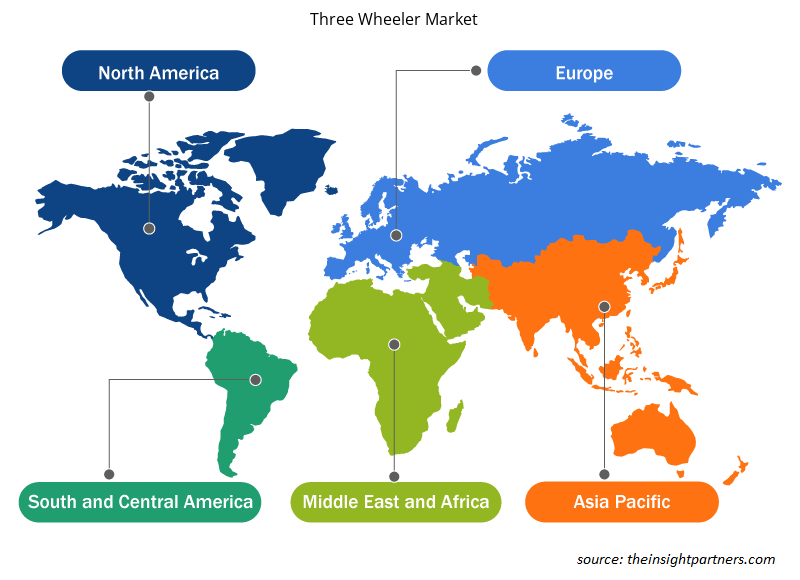三輪車市場は2018年に91億4,000万米ドルと評価され、2019年から2027年にかけて4.9%のCAGRで成長し、2027年までに137億3,000万米ドルに達すると予想されています。
三輪車は、乗客の輸送に使用される三輪車です。三輪車には、最低3人、最大5〜6人の乗客が乗車できます。地方では、必要に応じて6人以上の乗客が三輪車に乗って移動します。電動人力車は、三輪車の主な種類の1つです。電動人力車はバッテリーで動く環境に優しい乗り物で、従来の三輪車に比べて排出ガスが少なく、騒音も少ないです。電動人力車は、5〜6人の乗客を乗せて輸送できます。電動三輪車の需要の増加、人口の増加、およびこの地域の交通渋滞を緩和する乗り物の必要性の増加により、世界の三輪車市場の成長が促進されています。2018年には、予測期間中、アジア太平洋地域が三輪車市場で重要な位置を占めています 。インドなどの国は、予測期間中、国内および輸出ビジネスセグメントを支配すると予想されます。さらに、インドの多くの既存企業は、粒子状物質、窒素酸化物、硫黄の排出を抑制するために2020年までに実施されるBS(Bharat Stage)VI基準に準拠した三輪車の製造に注力しています。国内の農村部や準都市部での輸送手段の需要増加と人口増加により、中国で大きな成長が見られ、タイやマレーシアなどの他のアジア諸国がそれに続きます。
要件に合わせてレポートをカスタマイズする
このレポートの一部、国レベルの分析、Excelデータパックなど、あらゆるレポートを無料でカスタマイズできます。また、スタートアップや大学向けのお得なオファーや割引もご利用いただけます。
- このレポートの主要な市場動向を入手してください。この無料サンプルには、市場動向から見積もりや予測に至るまでのデータ分析が含まれます。
市場分析
環境に優しい三輪車の需要増加が市場の成長を牽引しているeco-friendly three wheelers is propelling the growth of the market
世界中の自動車業界では、三輪車メーカーの新規参入が絶えず増加しています。三輪車メーカーは、電動三輪車が世界中の顧客の関心を集めているため、この分野の発展を常に注視しています。世界の自動車業界では、従来の三輪車から電動三輪車への大きな転換が起こっています。three-wheelers to electric three-wheelers.
さまざまな国の政府が電動三輪車の導入に積極的に取り組んでいます。たとえば、インドの重工業・国営企業省は2018年3月、FAME India SchemeのフェーズIIを開始しました。これは2019年4月1日に開始され、今後3年間で総額13億9,000万米ドルの予算支援が行われます。このフェーズは主に公共交通機関と共有交通機関の電化を支援するために開始され、補助金を通じて7,000台の電動バス、50万台の電動三輪車、55,000台の電動四輪乗用車、100万台の電動二輪車を支援することを目指しています。FAME Schemeのこのフェーズでは、EVユーザーの信頼を高めるために、適切な公共充電インフラを構築することを目指しています。これにより、重工業・国営企業省は、産業界や公共部門企業(PSE)、政府機関など、さまざまな関係者の関与と積極的な参加を期待しています。市場の主要プレーヤーは、電気自動車の開発を目指しています。たとえば、イタリアの自動車メーカーであるピアッジオ&C. SpAは、ピアッジオ エイプ エレクトリク 電動3輪車のシリーズでピアッジオ エイプ E-Cityを発売しました。この電動車には交換可能なリチウムイオン電池が搭載されており、1回の充電で約70~80kmの走行が可能です。さらに、2019年8月、オイラー モーターズは、2020年初頭にインドで電動3輪軽商用貨物車を発売すると発表しました。
地理的に見ると、インドと中国には数多くの三輪車メーカーがあり、電動三輪車の普及も年々急速に進んでいます。インドと中国以外にも、ブラジル、アルゼンチンなどの南米諸国、南アフリカ、ナイジェリア、エジプトなどの中東・アフリカ諸国でも、自動車産業における電動三輪車の導入が急速に進んでいます。アジア太平洋地域は自動車産業において大きな成長を遂げており、優位に立っています。しかし、この地域で事業を展開する自動車企業は、電動三輪車の導入を飛躍的に拡大するために、部品プロバイダーとのパートナーシップの数を増やす必要があります。他の市場プレーヤーとの戦略的パートナーシップ、コラボレーション、契約、買収は、業界プレーヤーが市場を牽引する主な要因であり、今後数年間で世界中の三輪車市場を牽引すると予想されています。
タイプインサイト
タイプ別セグメントでは、世界の三輪車市場で旅客輸送車が最大のシェアを獲得しました。旅客輸送車は、さまざまな民間輸送業者や輸送業で収入を得ている個人が購入できる最も安価な輸送手段です。このセグメントの成長は、適切な道路の不足、三輪車の主な原因である輸送施設の不足、および交通渋滞がひどい都市部など、低コストの旅客輸送車に対する需要の増加によって推進されています。
燃料タイプの洞察
三輪車市場は、燃料の種類によって、ディーゼル、ガソリン、CNG、LPG、電気に分類されます。ガソリン部門は、世界の三輪車市場で大きなシェアを獲得しました。
市場イニシアチブは、企業が世界中で事業を拡大し、高まる顧客需要を満たすために採用する戦略です。三輪車市場に存在する市場プレーヤーは、高度な機能とテクノロジーを統合することで、主に製品とサービスの強化に注力しています。パートナーシップ、契約、合弁事業に署名し、世界中で新しいオフィスを開設することで、企業は市場シェアとブランドの存在感を高めようとしています。市場イニシアチブのほとんどは、将来の市場成長の可能性が高いアジア太平洋地域で見られました。以下にいくつかを挙げます。
2019年:2019年12月、Greaves CottonはTVS Motor Companyとの提携を発表しました。この提携により、Greaves CottonはインドにおけるTVS Motorの三輪車の公認サービスセンターとして機能します。
2018年:ATUL Auto Limitedはインドに拠点を置く自動車部品会社JBM Industriesと提携しました。同社は三輪電気自動車事業を拡大するために提携しました。
三輪車市場の地域別分析
予測期間を通じて三輪車市場に影響を与える地域的な傾向と要因は、Insight Partners のアナリストによって徹底的に説明されています。このセクションでは、北米、ヨーロッパ、アジア太平洋、中東、アフリカ、南米、中米にわたる三輪車市場のセグメントと地理についても説明します。

- 三輪車市場の地域別データを入手
三輪車市場レポートの範囲
| レポート属性 | 詳細 |
|---|---|
| 2018年の市場規模 | 91億4千万米ドル |
| 2027年までの市場規模 | 137億3千万米ドル |
| 世界のCAGR(2018年 - 2027年) | 4.9% |
| 履歴データ | 2016-2017 |
| 予測期間 | 2019-2027 |
| 対象セグメント | タイプ別
|
| 対象地域と国 | 北米
|
| 市場リーダーと主要企業プロフィール |
|
市場プレーヤーの密度:ビジネスダイナミクスへの影響を理解する
三輪車市場は、消費者の嗜好の変化、技術の進歩、製品の利点に対する認識の高まりなどの要因により、エンドユーザーの需要が高まり、急速に成長しています。需要が高まるにつれて、企業は提供品を拡大し、消費者のニーズを満たすために革新し、新たなトレンドを活用し、市場の成長をさらに促進しています。
市場プレーヤー密度とは、特定の市場または業界内で活動している企業または会社の分布を指します。これは、特定の市場スペースに、その市場規模または総市場価値に対してどれだけの競合相手 (市場プレーヤー) が存在するかを示します。
三輪車市場で事業を展開している主要企業は次のとおりです。
- ATULオートリミテッド
- ピアッジオ&C. SpA
- バジャジオート株式会社
- JSオート株式会社
- スピーゴ・ビークルズ株式会社
免責事項:上記の企業は、特定の順序でランク付けされていません。

- 三輪車市場のトップキープレーヤーの概要を入手
三輪車市場 – タイプ別
- 旅客輸送
- 貨物運送業者
三輪車市場 – 燃料タイプ別
- ディーゼル
- ガソリン
- 天然ガス
- LPG
- 電気
地域別世界の三輪車市場
北米
- 私たち
- カナダ
- メキシコ
ヨーロッパ
- フランス
- ドイツ
- イタリア
- 英国
- ロシア
- その他のヨーロッパ
アジア太平洋
- 中国
- インド
- 韓国
- 日本
- オーストラリア
- その他のアジア太平洋地域
その他の国
- アフリカ
- ラテンアメリカ
企業プロフィール
- ATULオートリミテッド
- バジャジオート株式会社
- JSオート株式会社
- マヒンドラ&マヒンドラ株式会社
- ピアッジオ&C. SpA
- スクーターズ・インディア・リミテッド
- スピーゴ・ビークルズ株式会社
- テラモーターズ株式会社
- TVSモーターカンパニー
- 湘河強勝電動三輪車工場
- 過去2年間の分析、基準年、CAGRによる予測(7年間)
- PEST分析とSWOT分析
- 市場規模価値/数量 - 世界、地域、国
- 業界と競争環境
- Excel データセット



Report Coverage
Revenue forecast, Company Analysis, Industry landscape, Growth factors, and Trends

Segment Covered
This text is related
to segments covered.

Regional Scope
North America, Europe, Asia Pacific, Middle East & Africa, South & Central America

Country Scope
This text is related
to country scope.
よくある質問
The three-wheeler passenger carrier segment dominates the global three-wheeler market as it is one of the cheapest transport vehicles that can be afforded by various private transport operators and by individuals whose earning is from transport jobs. Asian countries like Bangladesh, Sri Lanka, and Nepal and African countries like Ghana, Nigeria, Tanzania, and Kenya accounted for more than 90% of the exports in the Indian three-wheeler PC market. During 2018, the ICE-powered three-wheelers segment accounted for the significant shares and dominated the three-wheel passenger carrier market due to the increased usage of diesel, gasoline, bio-diesel, and compressed natural gas/liquefied petroleum gas (CNG/LPG) to power the engine in developing nations. In Asia-Pacific, India is the major contributor to the three-wheeler passenger carrier market
The key players in the market are focusing on investing in the production of three wheelers in African and South American countries. There have been prominent strategies made in recent years by automakers to increase the usage of three wheelers in these regions. For instance, in August 2016, Lohia Auto Industries entered Africa with three wheeler operated on diesel. A reduction in organized public transport systems has led to rapid growth in non-conventional means of public transport, initially provided by minibuses and shared taxi/vans, and more recently by commercial three-wheelers. Unlike cities in South and East Asia, ownership and use of motorized and electric three-wheelers as a personalized vehicle is extremely small in sub-Saharan cities
The massive populations of China and India and the mounting middle-class population in these countries, as well as booming automotive sector scenarios in both countries, are anticipated to have a bright future for the adoption of three-wheeler vehicles. These countries are the hub for various local automakers, which are focusing on the development of a three-wheeler vehicle, most commonly known as auto-rickshaw/ tuk-tuk. Furthermore, China is the largest producer of passenger cars across the globe; also, India, Japan, and South Korea are some of the primary vehicle manufacturing countries. The continuous economic growth in developed and developing countries such as India and China, coupled with the presence of a high number of manufacturers in countries such as China and Japan, has facilitated the rapid growth of the automotive industry in this region
Trends and growth analysis reports related to Automotive and Transportation : READ MORE..
The List of Companies - Three Wheeler Market
- ATUL Auto Limited
- Piaggio & C. SpA
- Bajaj Auto Ltd
- J.S. AUTO (P) LTD.
- Speego Vehicles Co Pvt Limited
- Mahindra & Mahindra Ltd.
- Scooters India Limited
- TVS Motor Company
- Terra Motors Corporation
- Xianghe Qiangsheng Electric Tricycle Factory
The Insight Partners performs research in 4 major stages: Data Collection & Secondary Research, Primary Research, Data Analysis and Data Triangulation & Final Review.
- Data Collection and Secondary Research:
As a market research and consulting firm operating from a decade, we have published and advised several client across the globe. First step for any study will start with an assessment of currently available data and insights from existing reports. Further, historical and current market information is collected from Investor Presentations, Annual Reports, SEC Filings, etc., and other information related to company’s performance and market positioning are gathered from Paid Databases (Factiva, Hoovers, and Reuters) and various other publications available in public domain.
Several associations trade associates, technical forums, institutes, societies and organization are accessed to gain technical as well as market related insights through their publications such as research papers, blogs and press releases related to the studies are referred to get cues about the market. Further, white papers, journals, magazines, and other news articles published in last 3 years are scrutinized and analyzed to understand the current market trends.
- Primary Research:
The primarily interview analysis comprise of data obtained from industry participants interview and answers to survey questions gathered by in-house primary team.
For primary research, interviews are conducted with industry experts/CEOs/Marketing Managers/VPs/Subject Matter Experts from both demand and supply side to get a 360-degree view of the market. The primary team conducts several interviews based on the complexity of the markets to understand the various market trends and dynamics which makes research more credible and precise.
A typical research interview fulfils the following functions:
- Provides first-hand information on the market size, market trends, growth trends, competitive landscape, and outlook
- Validates and strengthens in-house secondary research findings
- Develops the analysis team’s expertise and market understanding
Primary research involves email interactions and telephone interviews for each market, category, segment, and sub-segment across geographies. The participants who typically take part in such a process include, but are not limited to:
- Industry participants: VPs, business development managers, market intelligence managers and national sales managers
- Outside experts: Valuation experts, research analysts and key opinion leaders specializing in the electronics and semiconductor industry.
Below is the breakup of our primary respondents by company, designation, and region:

Once we receive the confirmation from primary research sources or primary respondents, we finalize the base year market estimation and forecast the data as per the macroeconomic and microeconomic factors assessed during data collection.
- Data Analysis:
Once data is validated through both secondary as well as primary respondents, we finalize the market estimations by hypothesis formulation and factor analysis at regional and country level.
- Macro-Economic Factor Analysis:
We analyse macroeconomic indicators such the gross domestic product (GDP), increase in the demand for goods and services across industries, technological advancement, regional economic growth, governmental policies, the influence of COVID-19, PEST analysis, and other aspects. This analysis aids in setting benchmarks for various nations/regions and approximating market splits. Additionally, the general trend of the aforementioned components aid in determining the market's development possibilities.
- Country Level Data:
Various factors that are especially aligned to the country are taken into account to determine the market size for a certain area and country, including the presence of vendors, such as headquarters and offices, the country's GDP, demand patterns, and industry growth. To comprehend the market dynamics for the nation, a number of growth variables, inhibitors, application areas, and current market trends are researched. The aforementioned elements aid in determining the country's overall market's growth potential.
- Company Profile:
The “Table of Contents” is formulated by listing and analyzing more than 25 - 30 companies operating in the market ecosystem across geographies. However, we profile only 10 companies as a standard practice in our syndicate reports. These 10 companies comprise leading, emerging, and regional players. Nonetheless, our analysis is not restricted to the 10 listed companies, we also analyze other companies present in the market to develop a holistic view and understand the prevailing trends. The “Company Profiles” section in the report covers key facts, business description, products & services, financial information, SWOT analysis, and key developments. The financial information presented is extracted from the annual reports and official documents of the publicly listed companies. Upon collecting the information for the sections of respective companies, we verify them via various primary sources and then compile the data in respective company profiles. The company level information helps us in deriving the base number as well as in forecasting the market size.
- Developing Base Number:
Aggregation of sales statistics (2020-2022) and macro-economic factor, and other secondary and primary research insights are utilized to arrive at base number and related market shares for 2022. The data gaps are identified in this step and relevant market data is analyzed, collected from paid primary interviews or databases. On finalizing the base year market size, forecasts are developed on the basis of macro-economic, industry and market growth factors and company level analysis.
- Data Triangulation and Final Review:
The market findings and base year market size calculations are validated from supply as well as demand side. Demand side validations are based on macro-economic factor analysis and benchmarks for respective regions and countries. In case of supply side validations, revenues of major companies are estimated (in case not available) based on industry benchmark, approximate number of employees, product portfolio, and primary interviews revenues are gathered. Further revenue from target product/service segment is assessed to avoid overshooting of market statistics. In case of heavy deviations between supply and demand side values, all thes steps are repeated to achieve synchronization.
We follow an iterative model, wherein we share our research findings with Subject Matter Experts (SME’s) and Key Opinion Leaders (KOLs) until consensus view of the market is not formulated – this model negates any drastic deviation in the opinions of experts. Only validated and universally acceptable research findings are quoted in our reports.
We have important check points that we use to validate our research findings – which we call – data triangulation, where we validate the information, we generate from secondary sources with primary interviews and then we re-validate with our internal data bases and Subject matter experts. This comprehensive model enables us to deliver high quality, reliable data in shortest possible time.


 このレポートの無料サンプルを入手する
このレポートの無料サンプルを入手する